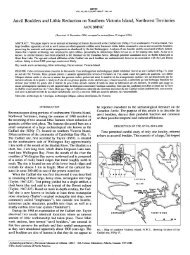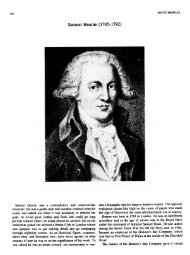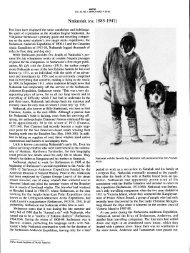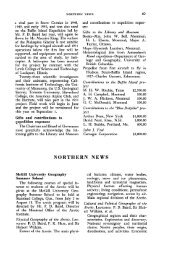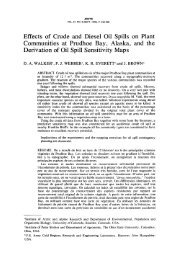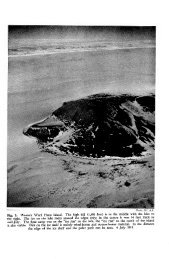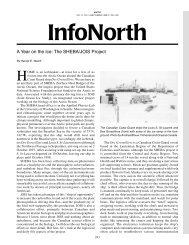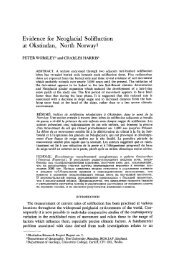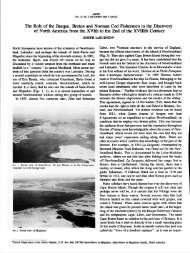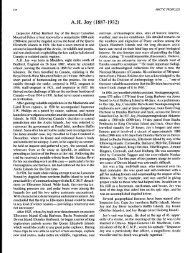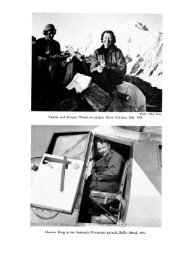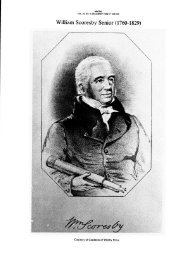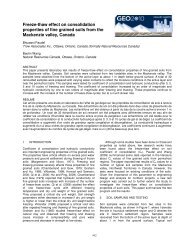NOTES ON THE NUNAMIUT ESKIMO AND MAMMALS OF ... - arctic
NOTES ON THE NUNAMIUT ESKIMO AND MAMMALS OF ... - arctic
NOTES ON THE NUNAMIUT ESKIMO AND MAMMALS OF ... - arctic
You also want an ePaper? Increase the reach of your titles
YUMPU automatically turns print PDFs into web optimized ePapers that Google loves.
184 <strong>THE</strong> <strong>NUNAMIUT</strong> <strong>ESKIMO</strong> <strong>AND</strong> <strong>MAMMALS</strong> <strong>OF</strong> <strong>THE</strong> ANAKTUVUK PASS REGI<strong>ON</strong><br />
Microtus miurus was seen in isolated colonies in some places where favourable<br />
habitat was limited. Seepage areas on the mountain sides, grown to<br />
Therofon Richardsonii and Cassiope tetragona with a dense cover of Rhytidiunz<br />
rugosum, though usually quite small in area, often supported a large population.<br />
One of the largest colonies occurred in and around a semi-submerged sedgebog,<br />
with the nest burrows in nearby solifluction terraces. Clear-cut runways<br />
were not always developed, but were seen best in wet lowlands grown to sedge,<br />
on solifluction terraces, and on dry, rocky, Dryas-covered slopes.<br />
Runways were seen to extend for considerable distances on the mountain<br />
sides. On one south-facing slope, at an altitude of about 2,500 feet, a single,<br />
well-worn runway ascended from a creek bed for a distance of fifty-six<br />
metres. At its highest point it branched, one branch running east along a<br />
solifluction terrace for a further fifty metres, while the other branch ran<br />
perpendicular to it for about twenty metres. The main burrows of the voles<br />
were in the terrace and. in the creek bank. However, thirty-one holes or<br />
groups of holes, from one to three metres apart, were found along the<br />
runway up the mountain.<br />
main<br />
Burrows were numerous, and in the main valley were usually marked by<br />
little heaps of evenly-granulated black earth at the openings. Earth expulsion<br />
seemed to depend partly on the character of the soil, and was greatest in the<br />
late summer when storage chambers were being excavated in small mosscovered<br />
hummocks. Excavation of this type has been described by Rand<br />
(1945) for M. andersoni. M. miurus stores the rhizomes of Carex spp. and<br />
other plants in these chambers for winter use. A typical chamber measured<br />
30 x 20 x 10 cm., and contained 1,367 rhizomes weighing 820 grams. These<br />
roots were not identified; however, Carex aquatilis and C. Bigelowii were<br />
abundant nearby. The Nunamiut at times search out such stores for their<br />
own use, and caribou may also tear them open with their feet to eat the<br />
contents. I found that M. miurus at Lake Schrader cached large stores of<br />
Polygonum viviparum roots; they also dried piles of willow twigs for storage,<br />
but I never observed this behaviour in the Anaktuvuk Pass region during three<br />
summers’ work. Rand (1945) reported that rhizomes of C. scirpoidea were<br />
stored by M. andersoni.<br />
Reproduction began in A4ay and ceased by September 1. The males<br />
showed a definite testicular regression by early September.<br />
number usually from 4 to 8, with an average of 6.<br />
The young<br />
During the spring of 1950 short-eared owls were particularly numerous<br />
in areas where this vole was abundant. These were probably migrant birds,<br />
since no nests were observed. As mentioned earlier, this vole is often dug out<br />
by the <strong>arctic</strong> grizzly, and is also preyed upon by foxes and weasels.<br />
Four specimens were trapped in the Savioyok valley during October 1950.<br />
This vole does not seem to extend far into the timbered country; but the<br />
southern limits of its distribution have not yet been determined.<br />
From his observations on a closely-related form, M. m’urus oreas Osgood,<br />
on the Seward Peninsula, Quay (1951) concluded that: “This vole was less<br />
generally distributed than oeconoms and seemed to have more critical habitat



